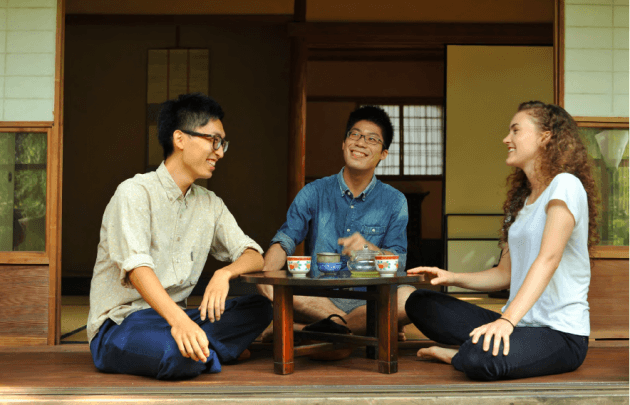
A traditional Japanese home stands on a hill overlooking Daitoku-ji Temple in Kyoto. It is named Totousha (陶々舎), evoking the Japanese word for intoxication, either from drink or from looking at something spell-bindingly beautiful (陶酔). In it live three tea practitioners in their late twenties: Dairik Amae, Kiki Geisse, and Fukutaro Nakayama, who think of the space as “a house living with tea.” The descriptions are vague by nature— it is not a business, but it is open to the community, showing how three young individuals can breathe modernity into a traditional way of life.
Early Saturday morning, I meet Dairik for a simple breakfast and to help prepare for a tea gathering. While we wait for the rice to steam and the taro to soften, we sweep the pine needles from the front of the house and wash down the stone foyer where guests will remove their shoes. Dairik recently finished a garden that winds along the side of the house, featuring a stone path surrounded by moss and shaded by carefully trimmed trees. While sliding open the windows in the tearoom, Dairik says, “The house needs to breathe, the feeling of freshness is very important.” It is a warm day for early December and the sunlight streams in.
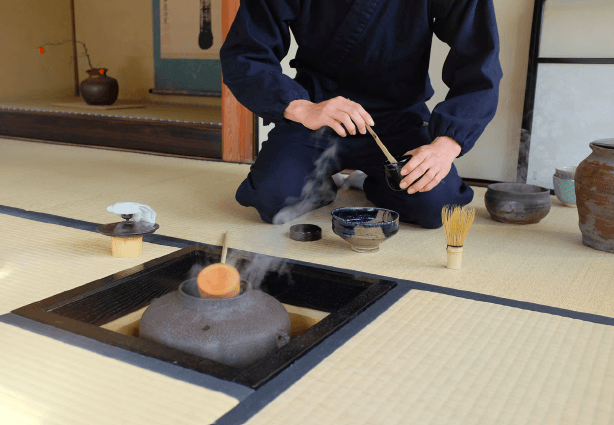
Dairik preparing the first bowl of tea
I had arrived that morning groggy and winded from the bike ride. Dairik had slept in and only woke to the doorbell. But by the time the house was ready, we were feeling awake and refreshed. We had gotten up and cared for something as if it were alive. And in a way, the house is alive. These traditional homes are made of organic materials that change and age with us, a relationship that I later learn is an important part of life at Totousha.
Traditional Japanese tea gatherings are performed in chashitsu, literally “tea room.” Entering through the sliding door, your eye is drawn to the sunken hearth in which an iron kettle sits, steam rising from its half-open lid. Sitting on the glossy tatami mat floor, you see the alcove in perfect view, displaying calligraphy and a flower arrangement. For most of us, our homes provide no such space. Living in an old style Japanese house is rare these days, especially among the younger generation, as they are difficult to maintain and considered impractical for the modern age. When asked why they chose to live in one, Dairik, Kiki, and Fukutaro offer one reason: to do tea. They hope to reawaken the spirit of tea gathering, a living culture that is fading into museums and history books.
Kiki explains: “After going to tea school, if you don’t move yourself to do tea, no one is going to do it for you. Of the graduated students, most of them don’t practice tea, or they go to classes but don’t enjoy their own gatherings. It’s a hassle to reserve a tearoom, pay expensive fees, and bring everything there. It’s not welcoming or an easy, fun thing to do. So much of your energy goes into it that by the time you’re serving the tea, you want to go home.”
Kiki is from Chile and attended university in Hawaii where the largest Japanese tea school, Urasenke, was prevalent and accessible. Majoring in Japanese studies, she gravitated towards tea as a focus through which to understand and connect to a much larger history. Following graduation, Kiki was offered a position at Marukyu Koyamaen, a 300-year-old tea company in Uji, just outside of Kyoto. She happened to be looking for a house at the same time as Dairik, who was working as an architect in the city, when they found Totousha.
Fukutaro was born in Saitama, north of Tokyo. By day, he is an engineer in Osaka. Fukutaro became interested in studying tea after joining a university club. Tea clubs, one of the main ways the younger generation can experience tea gatherings, also struggle to find traditional spaces for practicing. Some schools are able to build tatami rooms specifically for this purpose, but others are not so lucky. Fukutaro recounted the story of a foreigner once asking him when his club holds tea ceremonies. At the time, he could not say for sure. “But now I understand. If I were asked the same question again, I would say, ‘If you want to, you can hold a tea gathering. Any time, any day.’”
For an architect, an engineer, and an office worker, a lifestyle centered around tea appears at odds with their day-to-day routines. But when the housemates are not working, they come together to host events for family and friends and some that are open to the public. While deeply respecting the long tradition of Japanese tea gathering, they are spontaneous and experimental. In the spring and autumn, you can find them preparing tea for passers-by on the banks of the Kamogawa River. They set up gatherings in architecturally interesting spaces like an old soy sauce cellar in Tatsuno City or on a tiny, enclosed stage in the backstreets of Gion. At home, the tearoom becomes an exhibition space for artists or for collaborative events with local businesses such as Funaoka Onsen, one of the oldest public baths in Kyoto. Almost all of these gatherings involve tea—as a beverage, but also as a focus around which to gather and enjoy the space, the artwork, and the company.
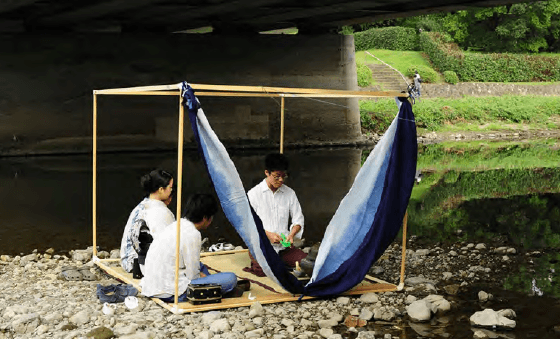
Fukutaro preparing tea for friends along the Kamogawa River
When asked, “Why tea?” Dairik explained: “The image of Kyoto is that there is culture everywhere. You look in the guidebook and there are traditional houses and people wearing kimono enjoying tea ceremonies. But the reality is not like this. The ordinary citizens don’t do tea or live in traditional homes. And I thought, ‘how can you call that culture if the majority of people aren’t doing it?’ Various Japanese traditions such as noh, kyogen, and ikebana are still being practiced and continue to evolve. But in the realm of tea, it seems like time has stopped. I wanted to experiment as to whether I could do tea and still have a job. Is that possible in this modern world?”
Dairik is Japanese but was born in Korea and lived in Hawaii, Russia, and Syria due to his father’s work in diplomatic service, having spent only three years in Japan by the time he was eighteen. He described how his homes abroad were often built in a traditional style—fit for that particular climate and location—and bemoaned how today’s urban housing is mostly of the same “cookie-cutter” style. Dairik believes that a person cannot fully experience daily life unless they inhabit a space that is unique to the region or country. “We should choose what is natural to that place.”
While attending Kyoto Seika University, Dairik became interested in the preservation of traditional Japanese architecture. “There were a lot of architects looking at the Japanese tea space. And in order to design the tearoom, I had to learn tea. So it was just an extension of my studies. But eventually my tea teacher opened the path and looking at how he lived, I wanted to understand, ‘Why does he seem so full of life?’”
The housemates of Totousha, like us, spend many of their waking hours looking at a computer screen, getting from one place to another, or scanning the horizon for future tasks and obligations. But tea can be a way to slow down. Dairik recounts, “My tea teacher’s house was a five minute walk from my old apartment. On the way there, I would be oblivious to the scenery, but on the way back, I would notice how very vibrant my neighbor’s greenery was. And I saw that there was grass growing out of the asphalt at the bottom of the street lamp. It looked so different, but it had always been there.” Fukutaro nodded in agreement and said, “It’s like how once we’ve learned to ride a bicycle, we don’t remember not knowing how. Now we’ve opened our eyes. We are practicing being sensitive.”

Dairik, Fukutaro and Kiki on the engawa veranda at Totousha
Dairik’s teacher once described tea as a normalization process, a way to reset in order to engage with the world with a clear mind. The candlelight dimly illuminates the people and things around us so we begin to use our eyes more earnestly. The quiet hiss of the boiling water does the same for our ears. There is a delicate smell of sandalwood from the shavings that were sprinkled on the charcoal. The weighty, textured bowl in our hands and the silky tatami beneath us awaken our sense of touch. The matcha is bitter and refreshing. Fukutaro says, “These days, we have so many ways to communicate with people. But in this small room, we can share the same time and smell and touch and so many things. Through these things we can show our true selves… Everyday, I go to Shin-Osaka. It’s a big, business city. Life is about AKB48, watching TV, sitting in front of the PC all day. After that, when I come back to this house and sit in the tearoom with my guests, I think, ‘This is real, this is real life.’”
After spending more time at Totousha, it became clear that the emphasis of the tea gatherings was more on the word “gathering” and less so on the tea itself. When I walked into the tearoom to record our interview on a weekday night, it had been converted to a dining room for the three housemates and their neighbors. It was nabe night and a steaming pot of broth, bowls, and large saké bottles decorated the low table. One neighbor, an artist who recreates traditional screen paintings for movie sets, had held a workshop that weekend, the outcomes of which lay drying around the room. An hour later, another neighbor stopped by with a long camellia branch. He had been trimming his tree and brought over the cutting. Later, I noticed a face peeking in through the window and an older man slid open the screen door, singing a song as he made his way into the room. Everyone laughed and Kiki joked he was singing for me.
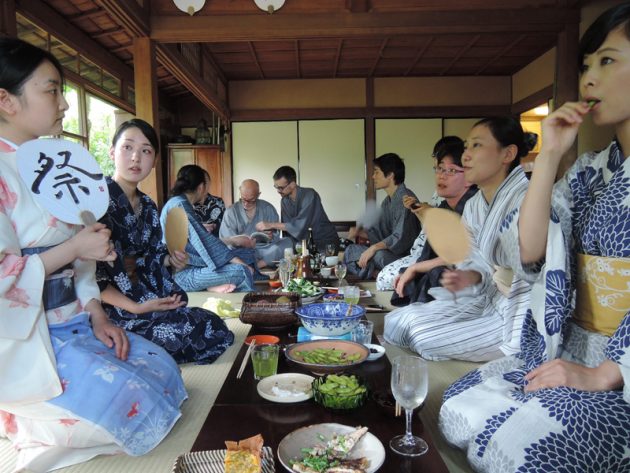
A light lunch after bathing at Funaoka Onsen

Nagashi somen party (a summertime tradition in which thin noodles are sent down a bamboo waterslide and caught with chopsticks)
The openness of their house struck me. Neighbors and friends came in and out freely, bringing things to share and seeking each other’s company. I commented on it and Kiki told me this story: By the book, there is a type of gathering where people get together just to admire a special scroll. I would read this and thought it sounded like a joke. But then it so happened that one day, our neighbor actually had a museum piece to show us. We put up the scroll and sat in front of it just talking while looking at this piece. So that, for me, was something new. These things might sound like old, ridiculous pastimes, but once you try them and you do it in a spontaneous way, they turn out to be very cool.
While the house is inhabited by individuals who still use the internet and watch movies, the timeless setting of Totousha evokes something within us—a desire to be fully present, open, and creative. And perhaps this community was formed beginning with the offering and accepting of a bowl of tea. “We can’t relate to one another when there is nothing to share,” Kiki said. “Then we begin saying things like, ‘I work here, I do this…’” Dairik continued, “Instead, I offer you a bowl of tea and if you accept it, I can open my heart.”
At work at Marukyu Koyamaen, Kiki gives weekly tours of the tea production plant. She describes the general flow of a ceremony and eventually brings them to a tearoom where, she says, sitting in the room together, people naturally realize they’re in a different place. Suddenly, everyone becomes quiet and aware of the other people on the tour. She says, “There isn’t any tea there, it’s just a brief moment.”
Tea is a medium through which we can interact with others, and the tearoom an aid. We enter naked in a way— just as the samurai would be stripped of their swords upon entering a tea ceremony, we leave behind the external markers of who we are—business cards, cell phones and all. Suddenly, we are just humans sitting next to other humans, sharing a bowl of tea.
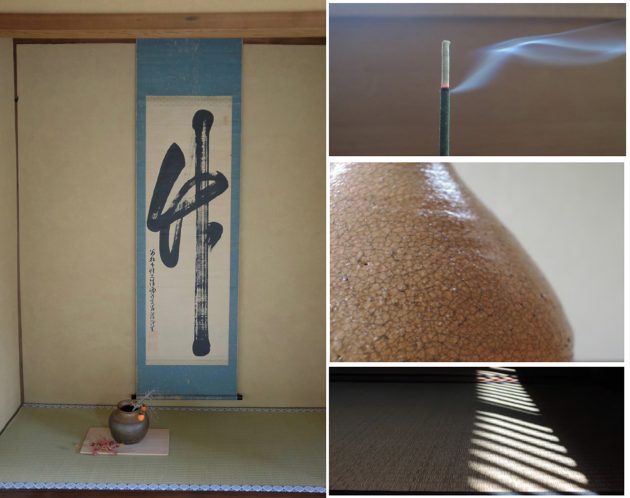
Quiet moments in the tearoom
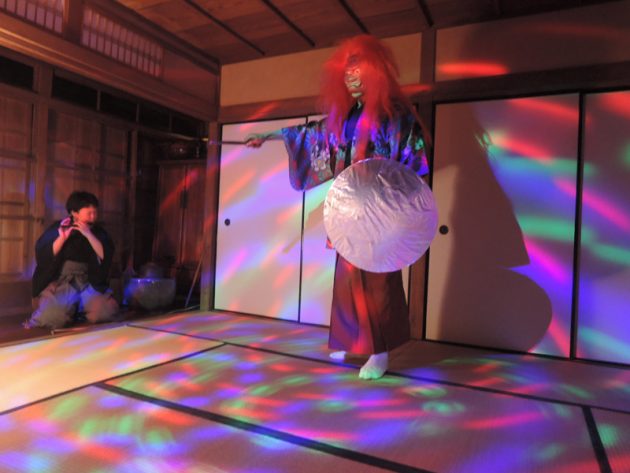
Noh performance at Totousha
A few weeks after our interview, I cycle back to Totousha for a noh performance. The sliding door between the tearoom and the adjacent room had been removed to create a stage of sorts, and nine of us sit on cushions surrounded by candles and heavy bowls of charcoal to heat the room. In such close proximity to the actors, we feel the ebb and flow of the performance intimately. Afterwards, Kiki and Dairik bring out low tables and beautiful containers of warm saké and tea. Together with the actors, we arrange into a circle and converse over drinks and a bowl of soup. There is impromptu singing and dancing as the liquids warm us through.
I think about the transformation of this small space—from the crisp atmosphere of a morning tea gathering, to the cozy, strewn-about indulgence of nabe night, and the pulsing collective energy of an intimate performance. The tearoom at Totousha is essentially an empty room, ready to adapt to any occasion. Its simplicity awakens our senses and, in the hands of Dairik, Kiki and Fukutaro, is able to spark both a sense of community and contemplation. Kiki said it well on the night of our interview: “We’re in the same room where we just had dinner. We were all eating and talking together, but when we clear out everything and just have tea, maybe we also start interacting differently. It’s not just about isolation or interaction. It’s about experimenting in the ways of communicating with others.”
In these moments, it is not about tea. At Totousha, life is filled with experimenting, learning, connecting, and caring for the space we inhabit. It is both lively and meditative. It seems fitting that such a place exists in Kyoto, a city that epitomizes the juxtaposition of old and new. A generation distant from the traditional arts can experience an intimate, renewed version of life in an old-style Japanese home, enriched by tea gathering. Kiki concludes, “Before living here, we had no idea how it felt. It was good to find that it was so good.”

After a number of years in Kyoto, Alex is now based in England working for the University of Cambridge. She enjoys exploring the intersection of art and food and continues to love and support KJ from afar.
Photos by Alexandra Ting, Arnaud Rodriguez, and Totousha (www.totousha.com)